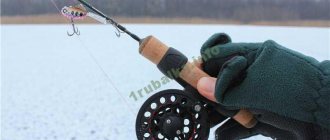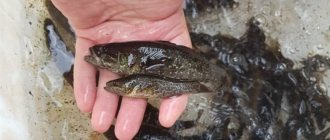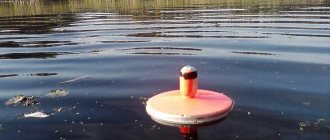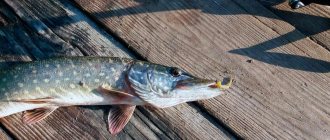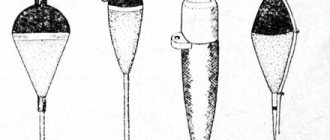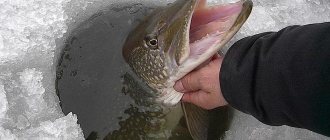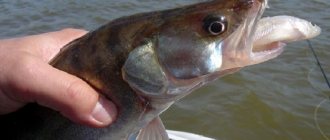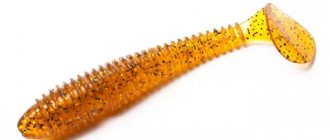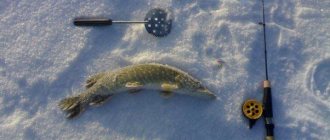Do-it-yourself pike zherlitsy and fishing with zherlitsy in winter
Pike jigs are winter bottom gear for catching predators with live bait. Catching pike on girders in winter requires knowledge of some points. Today we will talk about the intricacies of winter fishing for girders. We will talk about the following:
- Installation of girders for pike and equipment;
- How and from what to make a zherlitsa with your own hands;
- Which live bait is better and how to plant it correctly;
- Arrangement of girders on the ice of a reservoir;
- Subtleties in catching pike on girders in winter.
How to select and place live bait
The main bait for pike in winter is live bait of about 10 centimeters, which is found in the reservoir where fishing takes place. And it is desirable that the live bait resists. Perch or roach are best.
Methods for attaching live bait:
1) One of the methods of baiting bait is hooking through the gill cover. As a rule, it is left overnight. This will help him stay on his toes. Here it is important to thread the hook along the ridge and thread the tee so as not to harm the baitfish.
2) This method is simple, and you can use a single hook, which is used to hook the bait fish by the nostrils . It’s just important not to damage his nasal cavity, otherwise he won’t be active.
3) To prevent the lip of the live bait from tearing with this method of baiting, you need to have light weight gear. A single hook will work fine. In a strong current, the baitfish is hooked on the lower lip , and in a weak current, on both.
4) Threading behind the back is a popular method among anglers. The bait will be in its usual position, and there is no risk to the health of the bait fish. They pierce the bait with a hook between the ridge and the fin. However, these actions require skill.
By the way! More experienced fishermen know that large live bait up to 150 grams in weight is suitable for pike. She swallows it for a long time and can get caught on the tee.
When a predator has caught the bait and begins to eat it, you need not to flinch and hook it without delay or hesitation. They get the fish with a hook before it breaks the line.
Video: how to attach live bait to rigs and more
Video: how to prepare live bait for catching pike on girders
Pike baits
There are two types of winter fishing poles for pike:
- Classic over-ice girder for pike;
- Subglacial vent or postavusha.
Each type of vent has a huge number of design variations.
A classic over-ice pole for pike for winter fishing, consists of a pole rig and its holder along with a bite alarm in the form of a flag. That is why, when I catch pike on girders in winter, it is sometimes called fishing on flags. It is this type of girders that we will talk more about.
An under-ice vent (supply), as the name suggests, is installed under the ice. Most often, this type of vents is used for covert installation to avoid detection by strangers. Fishing with such girders follows the principle: set it up at night and check it the next day. An exclusively passive fishing method, more often used for catching burbot than pike.
Gear equipment
Regardless of the design, the equipment of the pike girder is mounted in the same way.
- Main line with a diameter of 0.3 – 0.4 mm;
- Sliding sinker "olive";
- A leader made of leader material, fluorocarbon or thicker line, or a flexible metal leader;
- Sharp treble, double or single hook.
For catching pike, a double hook (double) is most often used.
The length of the pike leash (the distance from the weight to the hook) depends on the depth and ranges from 0.5 to 1 meter (the deeper, the longer). The length can be adjusted by moving the load along the line.
The sinker must be capable of holding the baitfish at the desired horizon (weight depends on the size of the baitfish, depth and current). In shallow water (up to 1 meter) you can do without a load at all.
Installation of girder equipment for pike:
The device of the over-ice vent
The operating principle of the winter girder is based on the activation of a flag when a pike bites. In addition, the trap must provide the pike with free movement after the bait is grabbed, since it does not swallow it immediately.
A winter pike rig installed on ice consists of the following elements:
- Equipment;
- Gear stand;
- Reel (line holder) with a supply of fishing line;
- Bite alarm (flag).
The most primitive fishing rod can be considered a rig on a wooden fly, a flexible twig with a slot for fishing line and a red flag at its tip. When biting, the fishing line is pulled off the twig and it flies up, leaving a supply of fishing line on the ice for the pike to select. The blade is securely attached to the ice.
However, there are more advanced, convenient and at the same time simple designs.
The pole stand, the reel or line holder and the flag are the basis of the pole, which is one device that serves to interact with the pole equipment. The base of the girder is installed on the ice and can be designed as:
- Platform-cover for the hole;
- Tripod;
- Stand for installation in ice;
- Changeling or “cross”.
Vent on the platform-cover
The vent on the lid covers the hole, thereby slowing down the process of formation of an ice film. This is the most common type of girders. The device is a structure that includes the following elements:
- A flat platform-cover, most often in the form of a circle, with a slot for the fishing line;
- Vertical removable stand with a reel for equipment attached to it;
- A flag on a spring plate fixed in the platform.
After installing the girder, the flag is loaded into the coil by the stop. When there is a bite and the reel rotates, it is released and triggered - it straightens, signaling that the pike has taken a bite (it shoots).
Zherlitsa on legs (tripod)
A pier on legs, most often on three (tripod) is installed above the hole. This is a fairly simple and common design that includes:
- Folding support on legs;
- Reel for fishing line for jig rigs;
- Bite alarm - flag.
Zherlitsa on the counter
This is the simplest design. All elements of such a girder are fixed to a single stand, which serves as a support and is installed by freezing into ice or ice chips formed after drilling the hole.
Changeling priest or “cross”
The design of the shifter's vent is a tube that serves to store a supply of fishing line and is also a bite alarm. A removable cross made of metal rods is built into the tube. The fishing line of the girder equipment is wound directly onto one of the ends of the tube.
Zherlitsa “Cross” or “Shifter”
When a pike grabs a live bait, the changeling dives halfway into the hole, signaling a bite with the other end. The line is released freely, giving the pike free movement. The cross serves to install the shifter on the ice in its working position, and after a bite, it prevents the pike from dragging the entire structure under the ice.
According to a similar principle, but without plunging into the water, girders work on a platform with an overturning “flag”, which is also a reel.
Under-ice design (delivery, self-trap)
An under-ice girder (flagless girder, set-up, self-trap) is completely immersed in the water, fixed in the hole with the help of a bar or pole having a length greater than the diameter of the hole.
The most primitive design of an under-ice vent does not have a line-dropping device. It is tightly attached to the bar, and a small supply of fishing line, sprinkled with snow, is located on the ice.
Pike on a fishing pole
A more complex design of an under-ice fishing rod for pike has a device with a reserve of fishing line for the pike to move after the bait is caught. This is either a reel or a line holder capable of freely throwing off the fishing line.
Anglers have an ambiguous attitude towards flagless samolovkas. Many consider this method of catching a predator barbaric, extremely unsportsmanlike and unacceptable.
It should be noted that there are under-ice designs of vents with flags, but they are inconvenient and rarely used.
Other designs
In addition to the described designs of vents, there are many others that are modernization or independent design solutions. They may have fundamental differences in the methods of fastening the elements of the girder or a special design of the bite alarm, but in general, this does not matter much.
Do-it-yourself zherlitsa
Due to the simplicity of the design of the zherlitsa, lovers of homemade products make their own zherlitsa from scrap materials. Different designs of vents have different manufacturing complexity, but even the most complex ones can be made independently.
How to make a girder for a pike:
Fishing Features
They are used to catch pike, pike perch, and, less commonly, perch and burbot. Winter girders have a different appearance, but the same principle of operation - when bitten, the predator unwinds the fishing line from the reel, releasing the bite alarm in the form of a spring with a fabric flag. Previously, fishing poles were made independently, but now they are sold in any fishing store and only enthusiasts are interested in homemade products. There are various designs of vents, but there are several of the most common types:
On a flat platform. The wide base covers the hole, thereby protecting it from freezing and exposure. Disadvantages - these girders are quite low, they are difficult to see from afar, and in a snowstorm they are quickly covered with snow. But there are also models with a high stand - they are devoid of such disadvantages.
To see from afar whether a predator is reeling in the fishing line, draw a thick line on the reel with a dark marker.
On a tripod. The advantage of this design is its height and stability. The “burning” flag is visible from a considerable distance. Disadvantages - the hole remains open and in the cold it quickly sets in with ice, so it is sprinkled with snow or covered with a plywood or plastic cover.
On the counter. These girders are also clearly visible from afar. But they have a couple of disadvantages - installation requires drilling a socket under the stand, and this requires additional time and effort. In addition, the hole remains open and quickly freezes in frosty weather.
A flexible metal spring is used as a bite alarm. A “flag” made of brightly colored fabric is attached to its end.
Use different colors of flags depending on the snow cover of the reservoir. Red and blue are more visible on snow, while orange and yellow are more visible on wet or clear ice.
“Some fishermen additionally equip their fishing rods with bells and LED alarms. This is a great help at night, when it is difficult to see the flag being triggered, but you can hear the sound of the bell. And the fireflies will help determine the location of the fireflies.”
The best period for fishing on girders is the first (November-December) and last ice (March-April). The predator has a glutton, and you can catch it at any point in the reservoir throughout the day. With the advent of deep winter and deterioration of the oxygen regime, the bite weakens, but does not stop; the predator often abandons the bait or swallows it for a long time. The biting time is short, usually in the morning or afternoon. Sometimes the fish bite at the exits. You can sit all day without a bite, and in the evening in just 15-20 minutes you can see a lot of tans and catch several “tails”.
Catching pike on girders in winter: advice from experienced fishermen and a special technique
Hello to all avid fishermen from a winter fishing enthusiast!
